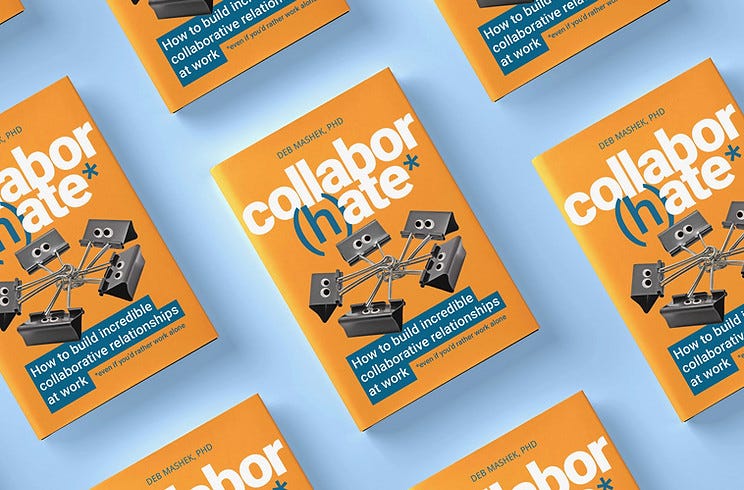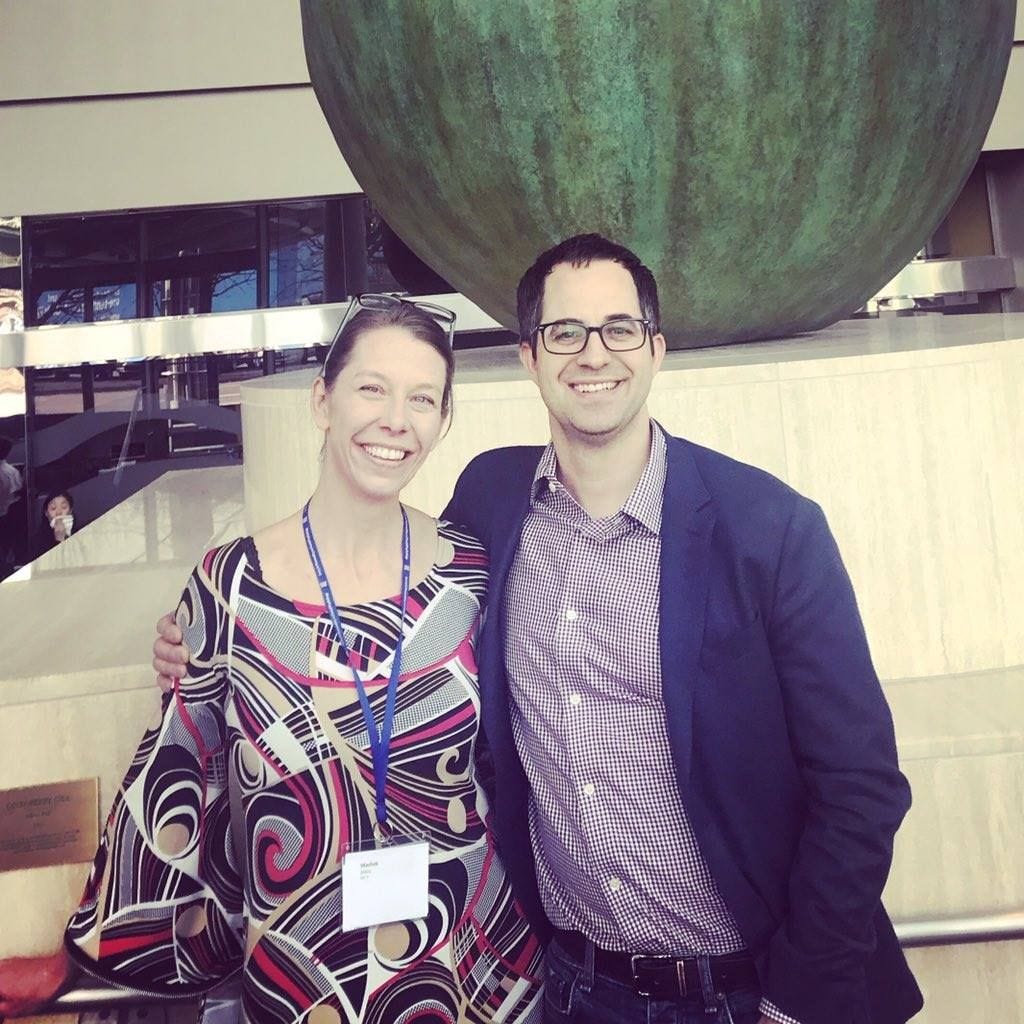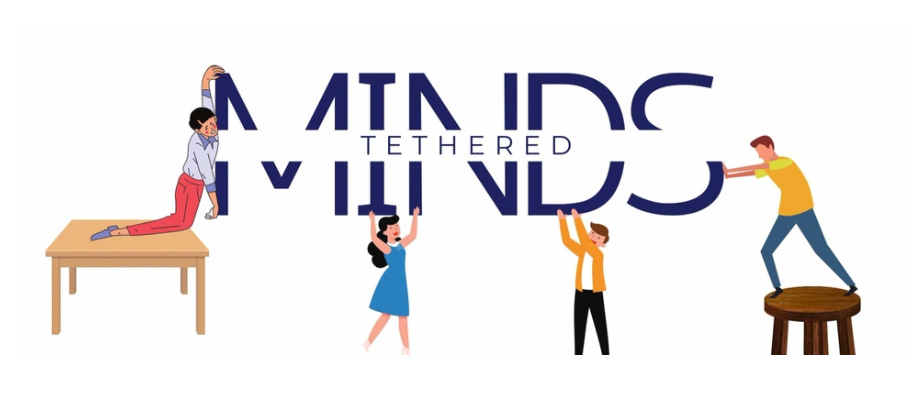INTERVIEW with Deb Mashek on Collabor(h)ate
Issue 64: We talk with Deb Mashek about her new book and how to build incredible collaborative relationships at work
This week, we are featuring an interview with Deb Mashek, who is releasing her book, Collabor(h)ate: How to Build Incredible Collaborative Relationships at Work, next week on January 24th! Dr. Mashek is a business advisor, professor, higher education administrator, and national nonprofit executive.
Her new book, Collabor(h)ate, teaches readers how to use the psychology of relationships in a work setting to create strong working relationships. Collaboration is essential for achieving complex goals, but it can also be a difficult and frustrating experience for many people. The book aims to help readers understand relationship quality, the elements of effective collaboration, and when and how to “get the heck out”!
In our interview, Deb shared practical advice for people who want to apply these ideas, such as being selective about which collaborations they engage in and being mindful of their own limitations and resources.
What does your book teach us about group dynamics?
Many people have mixed feelings about workplace collaboration. On the one hand, they know collaboration is essential to achieve complex goals. On the other hand, they know collaboration can be a total slog. People pull in different directions. There’s desperately little communication and even less follow through. One person ends up doing all the work. The result? Friction mounts. Projects fizzle. Great people walk.
Here’s why: Very few of us ever receive any formal training in how to collaborate well.
Collabor(h)ate applies key ideas from the psychology of close relationships to workplace collaboration. The book teaches readers what works and why when it comes to fostering collaborative relationships. (Hint: It’s not rocket science; it’s relationship science.)
What was the most surprising thing you learned as you were writing the book?
When preparing to write Collabor(h)ate, I was curious to know how common workplace collaboration is, how much professional development people receive in this critical skill, and how people feel about collaboration. To answer these questions, I conducted a survey of 1,100 people in the US, all of whom were employed full time.
The results surprised me: Most people (71%) spend over 3 hours per day collaborating with others. That’s a whole heckuva lot of togetherness. Yet, roughly a third of people had received no professional development in this critical skill. Given that, it’s unsurprising that most people (72%) had been in at least one collaboration that was “absolutely horrendous.”
Relatedly, when asked to describe their thoughts and feelings about collaboration, people used both positive and negative words including “opportunity,” “success,” “essential,” “potential,” “scary,” “risky,” “apprehension,” and “painful.”
In other words, a whole lot of people out there have mixed feelings about collaboration. They know it is ripe with potential and that it can be incredibly rewarding. And they know it can also be an incredible burden, ripe with headache and heartache.
What is the biggest unanswered question on this topic going forward?
A physician friend of mine recently told me, “Just because you’re not yet aware of a problem doesn’t mean you don’t have a problem.” He pointed out that a lot of people think their health is fine…until they get a diagnosis.
The same thing is true of collaborations. A lot of people think their collaborations are moving along fine…until they implode. That moment when someone realizes they have a problem is their “dysfunction awareness threshold.” It’s at that point--finally--that many people activate in search of a solution. The snag, of course, is that by the time you realize there’s a problem, it may be too late to reverse the situation. Or the fix may be too costly. Or the consequences may have already surfaced. Junky collaborations bust timelines, weaken bottom lines, and tank well-being. There’s a lot at stake.
So, the biggest unanswered question is this: How do we help business leaders and others see the early indicators of a collaboration problem so that they can turn the barge around before it’s too late? How do we help people unlock collaboration’s potential by ensuring we have collaborative people engaged in collaborative relationships within the context of a collaborative culture?
Do you have any practical advice for people who want to apply these ideas?
It makes zero sense to say yes to every collaborative opportunity that presents itself. None of us have the bandwidth for that. When we say yes to everything, we’re de facto saying no to everything because our efforts will be so diluted and ineffectual as to amount to intentional inaction.
And let’s face it: not all collaborative projects are destined for success. It is sometimes possible at the outset to see the bones that scaffold success or the red flags that foretell failure. Add in the fact that none of us are ideal candidates to contribute to every project, and it becomes clear that our involvement isn’t always going to be useful for advancing our own interests, much less the greater good. Saying yes to everything is thus just as useless as saying no to everything. Instead, you want to say yes to the right things. So what are the right things to say yes to?
Say yes to opportunities:
That align with your values, goals, and interests;
To which you are able to meaningfully and competently contribute
That are appropriately scaled for the resources available
That involve great collaborators who can meaningfully and competently contribute.
When any one of those four screening conditions is not met, the opportunity is almost certain to fall short of its promise. Say no. And, when the stars align and all these criteria shine bright? Say yes. These opportunities are (almost) destined to be collaborGREAT.
Fun fact: We met Deb when Jay was invited to debate her at the annual Society for Personality and Social Psychology Conference. They decided to meet for coffee before the big public debate and share notes. Even though they disagreed, the process itself was collaborative and fun rather than nasty and acrimonious. They tried to find common ground and genuine disagreements, and it made the debate much more fruitful. It goes to show, even in debate, people can find common ground for collaboration.
News and Updates
Dr. Steve Rathje of StevePsychology on Tiktok made a video with Jay discussing the psychology of cults and why people hold strong beliefs when in a cult.
Dom spoke with Amna Hyder on Tethered Minds — a new podcast that “blends storytelling and psychology to reveal the forces that ‘tether’ us together”. Our episode, A Clash of Identities, provides a deep dive into the science of identity and intergroup relations.
Catch up on the last one…
Last week’s newsletter featured our most popular newsletters of 2022 (plus a few hidden gems). Check it out if you’re new to the newsletter and let us know what you think!







